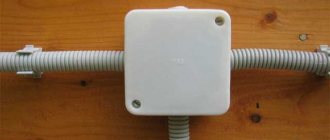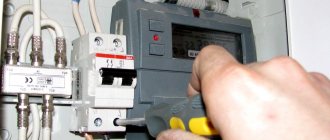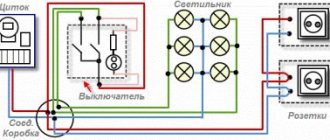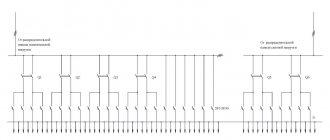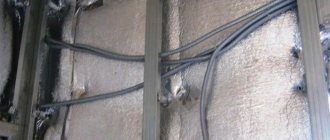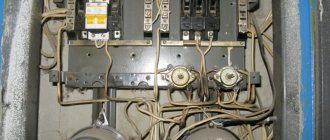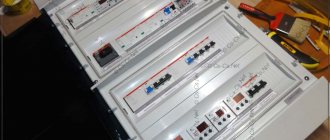In the construction of electrical wiring, distribution boxes play the role of power supply switching centers for a separate room in an apartment or a general distribution center for the entire complex of residential premises, from where power lines are distributed throughout the premises.
The main purpose of such a product is to reliably isolate the connection points between the electrical wiring lines of the room and the central power cable.
By its design, a distribution box is nothing more than a plastic box with specific holes on the sides for entering electrical cables and a special locking cover.
Classification
The classification of such product names as distribution boxes is most often carried out according to the type of installation:
For hidden wiring
It is intended for installation at the junction of wires in a special wall opening or partition voids , so that wiring laid in special channels or simply hidden by plaster does not come out. The cover of such a product, after installation and connection of the bends, is also hidden under plaster or putty.
For open wiring
The open arrangement of the distribution unit provides for fixing both the box itself and the boxes for laying electrical wires on top of the wall surface. This option is mainly present in electrical wiring equipment for office, industrial and commercial premises.
In private housing construction, external wiring is mainly for utility and technical rooms. The convenience of the outdoor option is quick access to the connection point of the wires, which makes them indispensable for rooms with a large number of consumers.
This division largely reflects the basic, but not the most complete classification of the characteristics of a given product. At the same time, this classification is the main one today for most sellers and consumers.
In addition to classification by type of installation, there is a classification by purpose and degree of safety of this equipment. This type of separation exists for special rooms and provides the greatest degree of safety for this type of room - protecting electrical equipment from the influence of the indoor environment.
This classification reveals more deeply the purpose of electrical distribution boxes, while each class has its own characteristics:
- Conventional protected distribution boxes - can be used both in ordinary premises and industrial premises, they are designed for a standard voltage of 220 V, most often have a lid without a rubber gasket, and the input points have standard rubber seals.
- Dust-proof boxes are designed for installation in rooms with a high content of dust or other dusty particles, the penetration of which into the housing can negatively affect the operation of the entire power supply system.
- Splash-proof options are designed for rooms with high air humidity; they have a special rubber gasket and rubber seals that provide reliable protection of the wire connection from moisture penetration inside.
- Fire resistant, increased strength. In rooms where explosive work is carried out, highly flammable liquids and materials are used, safety requirements must be ensured at the highest level; it is for such rooms that boxes are installed that ensure reliable fastening of both the wires themselves and their retention in special clamps inside the installation compartment.
Housing protection from solid bodies
The value of the first digit after the IP abbreviation can vary from 0 to 6.
Class 1
Protection is provided against accidental penetration of a person's hand through the body of a working device. It is allowed to install ventilation holes less than 50 mm in diameter on its surface. Larger objects will not fall through them.
The method is used for external switchboards, street switches with fuse links and other similar equipment. It is not used inside rooms.
Class 2
Protection against getting your finger inside the case is created by reducing the diameter of the ventilation holes to 12.5 mm. If the previous method was used for the external use of electrical equipment housings, for which additional fencing is created, then this method is widespread among household devices placed indoors.
These include electrical panels, distribution boxes and even plug sockets.
Class 3
Tools and wires must not enter through openings in the housing. The area of the cracks is limited to sections with a size of 2.5 mm.
Such surfaces are created on the casings of electrical devices of wide use, located inside living rooms, for example, boxes for installing an outlet or switch.
Class 4
With this method of protection, the access of foreign objects through slots 1 mm wide is limited. Not only ordinary home craftsman tools, but also pieces of wire and sections of wire should not pass through them.
Using this method, manufacturers produce sockets with curtains that reliably protect the internal circuitry. They are installed in the kitchen or bathroom.
Class 5
The housing completely eliminates the creation of internal damage due to the penetration of objects from the outside. Sand and fine dust in the air cannot cause significant harm.
Such casings are created for production equipment operating in dusty conditions, for example, metalworking shops. At home, there is little point in installing sockets with such protection.
Class 6
The body of the electrical appliance will not allow small particles of dust that are constantly in the air to pass through. It perfectly protects internal equipment from their penetration.
Such devices are often installed for outdoor use. They usually provide good protection against water penetration. This is a separate indicator of the IP standard. It is characterized by the second digit.
Device
box from inside
According to their technical purpose, distribution boxes must provide reliable insulation of the connection points of electrical wires from external influences and at the same time be quite small in size.
Most modern distribution boxes are plastic rectangular or round boxes of various sizes, with special perforated holes designed to enter wires inside the box.
Boxes for external fastening can have various options for fastening to the wall surface:
- External mounting holes.
- Internal mounting holes.
- External options designed for installation on cable tension lines, in addition, may have places for fastening to a cable.
Fittings for internal installation, unlike external elements, are mounted inside a wall or hollow plasterboard structures. A special feature of elements for brick, concrete walls, walls made of foam concrete is that they are fixed using mortar or putty. The reliability of such fixation is ensured by the presence of several special retaining grooves on the outside of the box walls.
For installation inside gypsum partitions, as well as for installing a distribution unit inside other hollow partitions, fastening can be done using screws through mounting holes in the bottom of the element or using special clamping or spacer elements of the structure.
The outer cover of such fittings is usually fixed with latches or screw connections. Internal boxes of simple design are closed by simply snapping the lid, external ones most often have a screw fixation.
Some products, in particular, boxes that provide for the use of protective grounding, have a rigidly fixed mounting strip inside, with holes and fixing clamp screws, for reliable fastening of the grounding wires.
Kinds
inner box
The branch device is classified into 2 types:
- Internal , for installation in the wall.
- Overhead , for open mounting.
The distributor for hiding wiring has the following conditional classification: for solid and empty walls . Containers of round and square shapes are available on sale.
External differences in devices for hollow walls include pressure holes for long self-tapping screws or screws. Quick-drying solutions are used for fastening.
Overhead devices are distinguished by their tightness and non-flammable properties. There are no puzzles in their design; Only round boxes at the inputs are distinguished by special “horns”, which are designed for increased tightness of the wiring.
Characteristics and dimensions
The choice of one or another element for installation largely depends on how well the accessory is suitable for installation in a particular location and meets the technical conditions and requirements.
Some of the most frequently put forward requirements for distribution boxes are:
- The material from which the product is made.
- External and internal dimensions suitable for use in each specific case.
The dimensions of the main types of polypropylene junction boxes may vary due to the specifications of manufacturers.
However, at the same time, most sizes of round-shaped polypropylene products, both for internal and external installation, can be:
- box with degree of protection IP55, diameter 65 and depth 40 mm;
- diameter 70 and depth 50 mm;
- diameter 80 and depth 50 mm;
These elements each have 4 cable entries with rubber plugs, which simultaneously act as a seal. Fixing the lid with a tight fit around the outer edge of the box.
Rectangular polypropylene distributors can be:
- with degree of protection IP55, dimensions 70x70x40 mm;
- with degree of protection IP55, dimensions 80x80x40 mm;
- with degree of protection IP55, size 100x100x50 mm;
- with degree of protection IP55, size 150x110x70 mm;
- with degree of protection IP55, size 120x80x50 mm;
- with degree of protection IP55 size 190x140x70mm;
- with degree of protection IP55, size 240x190x90mm;
- with degree of protection IP55 size 300x220x120mm;
- with degree of protection IP55 size 380x300x120mm;
- with degree of protection IP55, size 200x140x75 mm;
- with degree of protection IP55, dimensions 240x195x90 mm;
- with degree of protection IP54, dimensions 85x85x35 mm;
- with degree of protection IP54, dimensions 43x80x35 mm;
History of origin
As soon as people were able to invent the first electrical unit, where dozens of different cables and wires were connected, then a person immediately had a need to protect it. To prevent oxidation of contacts, as well as to protect a person from accidental contact with an electrical element. This eliminates electric shock, which creates safe operating conditions. In addition, the elements had to be limited from external factors, such as moisture, dust, etc.
The first thing scientists came up with was to protect the place of twisting with a special box, but at that time it was impossible to put such production on stream. Therefore, people found a way out of this situation and began to use cans. This method is still preserved in some settlements and does not look entirely aesthetically pleasing. Special holes were created in these cans where the cables were routed and then twisted. The most crucial moment was precisely creating the grooves, since it was not always possible to make the edges smooth and not jagged.
But as soon as progress went further, people began to forget about this method, because more practical and beautiful distribution boxes appeared. They look great in the apartment and provide the owner with reliable protection for the entire period of operation. But the reality is that there are people who still prefer to use cans because they think they are safer, although this is far from the case.
If you plan to carry out a complete repair with replacement of all wiring, then the purchase of a distribution element should also be included in the list of necessities. Their installation and cost will allow everyone to purchase the product, but it will give more useful things than a person can imagine. Today it’s easy to find such a product, just open a popular marketplace or just go to the first hardware store, there will be hundreds of such products. It is not recommended to use improvised means to create an imitation junction box, as this may cause more problems than practicality.
Box materials
Plastic
Of the entire range of materials used for the production of these products, plastic of various groups is most often used.
This technical solution is related to:
- With excellent dielectric properties of plastics.
- With low cost of production.
- With the ability to produce various shapes and sizes of products.
- Easily complete plastic products with various additional elements - rubber seals; mounting strips, ease of installation of fixing screws.
- With the long service life of such products, due to the absence of natural destruction of the material.
Metal
At the same time, when installing electrical wiring in warehouses, hangars, workshops, when not only rigid fastening of electrical wires is required, but also exposure to adverse factors in production premises, there is a need to install distribution boxes with higher performance characteristics.
In this case, the best case material would be metal. Metal boxes are made mainly by stamping from sheet metal, followed by priming and painting. Fixation of the cover is achieved using a screw connection. The tightness of the structure is increased with the help of rubber seals at the electrical cable entry points and a rubber seal on the lid.
Blitz tips
- According to generally accepted fire safety standards , distribution boxes must be installed in each apartment.
- If a wire connection catches fire, the distributor retains part of the wiring, and if it is missing, it will take a long time to look for the fault.
- You should not save on the purchase of such a device , otherwise in the event of a fire in the wiring, even greater financial waste will follow.
- The final stage of electrical wiring installation is connecting the input cable. If this rule is violated, the consequences may be irreversible.
- When working with wires, it is advisable not to use the “cold soldering” method, since such a connection is short-lived.
- Before purchasing a distributor. box, it is recommended to accurately measure the recess where it will be mounted in the future. This nuance is also important from an aesthetic point of view.
- The recess under the box is made with a hammer drill; additional attachments are used for concrete work.
- When purchasing a device, you need to study its technical data sheet. Pay special attention to the permissible voltage and load values, rules for safe operation, and the selected degree of protection.
Installation
In places where the main electrical wire is divided into separate lines, distribution boxes are installed in the building.
A special feature of their installation is the need to install a distributor. boxes at branching points according to the electrical wiring design. Usually, a place is chosen in the corner jambs, and depending on the height of the ceiling, 20-30 cm from the ceiling.
Installation is carried out in accordance with the following algorithm:
- At the point where the main wire enters , a distribution box is installed and firmly fixed in a pre-prepared place.
- Wires for power supply terminals for sockets, switches, chandeliers and lamps, terminals for powering stationary electrical appliances - air conditioners, gas boilers, boilers are carried into a box to a length of 5-7 cm.
- The wires are marked inside the box.
- The cable entry diagram is drawn onto the room's electrical wiring plan, with numbering and indication of the entry features (if necessary).
- The wiring connection is being made
- The twists are reliably insulated either with insulating tape or special caps.
- The twists are recessed inside.
- The lid closes.
- is being carried out to fix it with plaster or putty.
Compound
wire connection lines
Installation of connections of electrical wiring lines into a complete power supply system is carried out according to a predetermined scheme.
The calculation of loads and wiring cross-sections is determined at the design stage, but practical implementation is carried out as follows:
- The ends of the wires are 1.5-2 cm free from insulation.
- In the case of laying wiring from cables that have double insulation, the outer insulating layer is removed to a length of 4-5 cm.
- The wires are connected according to color , this is the simplest and easiest connection.
- Using pliers or other electrical installation tools, each twist is crimped and insulated either with electrical tape or a plastic cap.
- If the box contains terminal blocks or mounting blocks , then installation is carried out using a screw clamp, by pressing wires of the corresponding color on one plate.
- After connection, the wires are checked and placed in the box, and the lid is closed.
Connecting switches
The input wires are connected to the switches according to the principle of similarity. There are 2-3 wires from the power source. Each of them is responsible for phase supply, disconnection and grounding.
Accordingly, when connected, they will connect like this:
- shutdown to shutdown;
- ground to ground;
- summing up to summing up;
There is nothing complicated about connecting an outlet. The principle of color similarity, phase and working zero determination also works here. Each color corresponds to the color of the opposite contactor.
Review of models on the market
Junction box Tuso
Characteristics:
- diameter 60 mm, depth 40 mm;
- installation, or branching;
- round in shape, consisting of a body and a lid;
- body and cover material – non-flammable plastic;
- fixing the cover with latches in the cover and body;
- used for installation in concrete and brick walls;
- it is possible to mount it openly with screws or self-tapping screws;
- number of inputs – 4 with rubber seals;
- moisture protection class -;
Price – from 20.00 to 35.00 rubles per piece.
Distribution box Legrand Atlantic IK10
Characteristics:
- dimensions 150*150*80 mm;
- rectangular shape for indoor installation,
- metal;
- fixing the cover with screws into the body;
- used for installation in concrete and brick walls;
- Possible mounting through the body or on brackets;
- supplied with perforated mounting rails;
- moisture protection class – IP66;
- internal and external paintwork – textured coating in RAL 7035 color;
Price – from 3173.00 to 3300.00 rubles per piece.
Price
The cost of boxes varies from 150 to 10,000 rubles. The price depends on the type of distributor, number of inputs, configuration, main characteristics, design features and manufacturer rating.
For example, a plastic switch from TP ELECTRIC with 8 outputs and the most basic characteristics costs about 150 rubles. The price is relatively low, but such a distributor is inferior in terms of quality and has a short service life.
If you pay attention to a mid-level junction box, for example, from Abox, you will notice that it has more worthy characteristics: a level degree of protection according to GOST standards, increased dimensions, expanded equipment (terminals, caps), German production and assembly. Such a switch will cost from 500 rubles and more.
Recently, developers have decided to produce a new generation of boxes , where a combination of plastic and metal is appropriate. The Spelsberg distributor type WKE 3 is made of high-quality plastic (body) and stainless steel (stiffeners). Such a container has increased fire and heat resistance, high load capacity, a complete set with all the necessary seals, heat-resistant terminals and spare screws.
Its design attracts with its non-standard solution and practicality, but the price is also “biting” - 3,000 rubles. And this is not the limit. In any store or online electrical store you can find boxes for 4,000 and even 10,000 rubles.
Internal installation boxes have the same extensive pricing policy.
Same purpose, but different names
Arriving at the store, a person will notice that they sell dozens of different models, and they differ not only in shape, but also in names, so there are 4 main types:
- Exceptional;
- Unsoldered;
- Distribution;
- Branch.
A distribution box can be compared to a large station from which dozens of cars are dispatched. The element is a distribution point for the power source. Since all the wires go in different directions, the product is called “distribution”. The branch version is nothing more than an ordinary synonym; the product does not add any new functionality, everything remains at the usual level, even the same material is used.
The next name “junction box” came about because the wires that were inside the product were twisted and then soldered, since this method guaranteed more reliability. Therefore, most electricians gave the device this name. There are no functional features here either, it’s still the same standard box.
The last interesting name is “switch box”. As you can understand, the word “disconnection” does not exist at all in the Russian language, so it will not be possible to translate it into a foreign language. This name was given by professional electricians who combined two words: “distribution” and “connection”. Oddly enough, this option best describes the operating principle of such a box. First, the wires are distributed inside this element, and then connected according to the instructions or diagram.
Today there are hundreds of other ways to connect wires, for example, using a terminal block or welding. Also, some users use special clamps, which are highly reliable and durable. Despite this, in stores you can find another name for the distribution box: “soldered”, which is also strange, but familiar to some users.
All these names are described for a reason. Arriving at the store, a person will see for himself that such options are used there, even though they are not official. Choosing a box will become easier, as there will be a general understanding that, regardless of the label, the essence of the device is the same.
